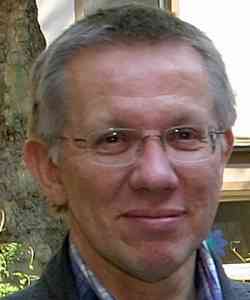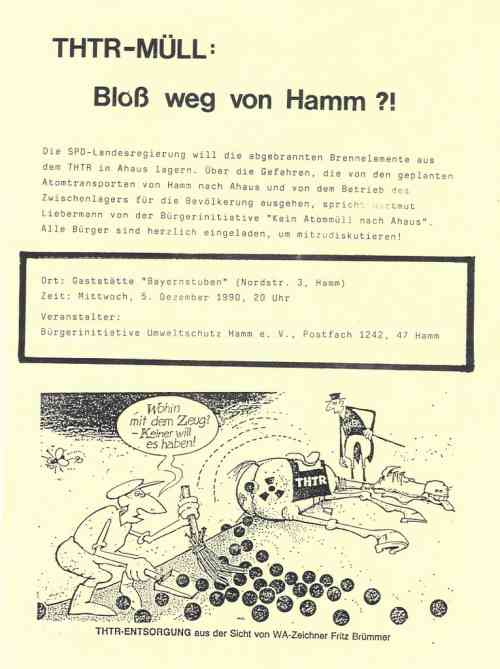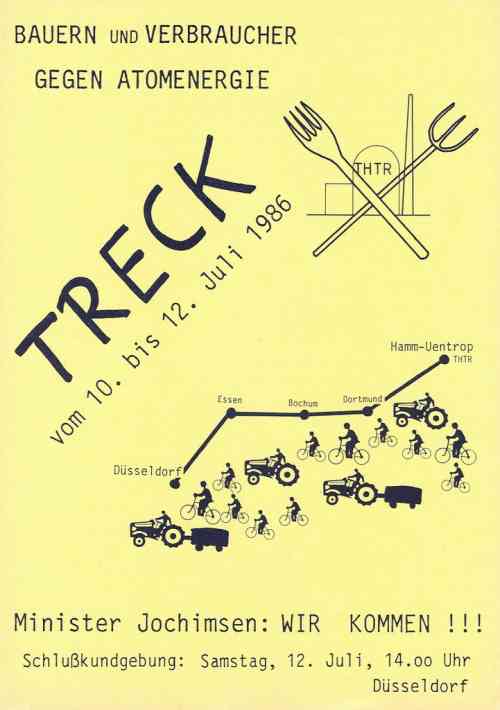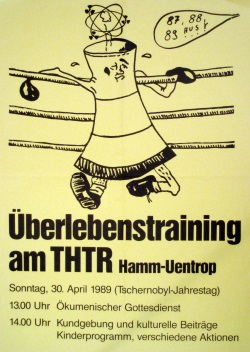| The reactor bankruptcy - THTR 300 | The THTR Circular |
| Studies on THTR and much more. | The THTR breakdown list |
| The HTR research | The THTR incident in the 'Spiegel' |
The THTR Circulars from 2009
***
| 2023 | 2022 | 2021 | 2020 | ||
| 2019 | 2018 | 2017 | 2016 | 2015 | 2014 |
| 2013 | 2012 | 2011 | 2010 | 2009 | 2008 |
| 2007 | 2006 | 2005 | 2004 | 2003 | 2002 |
***
THTR Circular No. 129, Dec. 2009
Content:
On the death of Theo Hengesbach
Duisburg, Mühlheim, Essen - the nuclear industry in the Ruhr area wants to make garbage in the Münsterland disappear.
THTR resistance exhibits as part of the European Capital of Culture RUHR.2010 are extremely topical!
On the death of Theo Hengesbach
 Theo Hengesbach died on November 15, 2009 at the age of 55 after a long period of cancer. He was one of the co-founders of the citizens' initiatives against nuclear power plants in the regions of Hamm and Dortmund and shaped them significantly for many years through his prudent, friendly and persistent example. He introduced us to the handling of nonviolent actions and civil disobedience.
Theo Hengesbach died on November 15, 2009 at the age of 55 after a long period of cancer. He was one of the co-founders of the citizens' initiatives against nuclear power plants in the regions of Hamm and Dortmund and shaped them significantly for many years through his prudent, friendly and persistent example. He introduced us to the handling of nonviolent actions and civil disobedience.
In Dortmund he went completely new ways in community work. As a social worker in the Kreuzviertel he campaigned for the rights of older people and for decades influenced state and federal politics in the area of work for the elderly. In 2000, Theo was appointed to the regional seniors' conference by the responsible NRW ministry. He received numerous awards for his commitment. His goal was not patronizing care, but an independent life in old age and more participation of older people at all levels. An important source of inspiration for him was the life and work of Mahatma Gandhi. He passed on his knowledge to us - not with missionary zeal, but as a selfless offer that we gladly accepted.
It started with a personal ad in issue 17 of the "Graswurzelrevolution" magazine in 1975 to find supporters against nuclear power plants. Theo Hengesbach and parts of the Nonviolent Action Arnsberg prepared to move to Dortmund for the purpose of studying. They dealt with the dangers of nuclear power plants and conveniently moved straight to the "lion's den". Dortmund was the seat of the United Electricity Works, which were responsible for the construction of the Thorium High Temperature Reactor (THTR) in Hamm. The grassroots revolution was read in the hammer group of the German Peace Society-United War Service Opponents (DFG-VK) and very soon there was an intensive personal exchange of views.
A few weeks later, before the actual founding of the citizens' initiative for environmental protection, we went with five people and a four-meter-high skeleton frame, posters and leaflets through the town center of Hammer. I was given a camera and took pictures because there was no photographer or journalist to be found for Saturday mornings. Two days later almost the entire Ruhr area press headlined "For the first time street protest against Uentrop nuclear power plant".
From now on everything went very quickly. Citizens' initiatives were a new phenomenon back then that we knew little about. New structures had to be set up and new forms of action tried out. Theo not only brought the papers and brochures of the Baden-Alsatian citizens' groups in his suitcase, which were a year or two ahead of us. But also books by Gandhi, Tolstoy and Kropotkins "Mutual Aid". The latter title already indicated at that time that he would not stop at abstract calls, but that practice-oriented community work would fill his future life.
Theo prepared meticulously with us for our first occupation in 1976. Next to the expensive atomic propaganda center of the VEW in Uentrop we didn't just set up our information tent after the barbed wire fence was overcome. Instead, there was a special preparation sheet for each of the over one hundred "squatters" with recommendations for action: Always be open to a friendly conversation - and stand firm. A sheet for the police: We are non-violent and want to protect you from radioactivity too. In addition, an extra sheet for the journalists in which the background of the action was explained. And for the curious spectators there was a sausage grill next to the information tent (dear vegetarians, we ask for your indulgence ...).
He showed us how to express oneself in press releases and conversations in such a way that most people could understand and understand what we were about. Patiently explanatory, polite, but also emphatic and determined. Doing the same was not always easy, it was often exhausting. In the following years many other political groups and parties tried to co-opt us as a citizens' initiative or to impose certain (pseudo-) militant actions or a verbally radical style of language on us.
Theo, on the other hand, was a completely different person. He was pleasantly reserved and considerate. Together with him, many of us viewed the "unbridled joy of exciting activity" (Gandhi) critically and tried to keep a clear head in the face of the Brokdorf hype that was widespread at the time. What was the point when tens of thousands of people drove hundreds of kilometers for a few hours to the alleged crystallization points of the anti-nuclear resistance, but in front of their own front door they didn’t move or change anything?
When, ten years later, in 1986, the major incident in the THTR worried the people in the region, the "farmers and consumers against nuclear power" insisted on their right to resist blockades and occupations in a non-violent way, just as they themselves did wanted - and had success with it after three years. For some others in the anti-nuclear movement, our "citizen-oriented" demeanor was too boring, not revolutionary and spectacular enough. When we had to listen to these bitter accusations over and over again, I often thought back to the early years, when Theo endured similar attributions with serenity and the certainty that decades later, based on the facts, history will make an objective judgment.
Theo sent us hundreds (!) Of letters with newspaper clippings, encouragement, suggestions and strategy proposals in Hamm - there was neither internet nor mailbox in the 70s and 80s. In the "Info for non-violent organizers", the more internal magazine of the grassroots revolutionaries, he analyzed the development of resistance against the THTR in a series of articles over 19 issues. Specialist articles in "Nonviolent Action" from the Reconciliation Union were added. Even if the fence fighters looked down contemptuously at the inconspicuous little nonviolent BI in Hamm - peace researchers and movement workers evaluated our experiences and experiments with the help of Theos critical reports of solidarity with great interest.
Theo wrote about his experiences in Hamm and Dortmund in the magazines "Nonviolent Action" (Association of Reconciliations) and "Umweltmagazin" (Federal Association of Citizens' Initiatives Environmental Protection). With his 77-page brochure "Civil Disobedience and Democracy" in 1979 he intervened in the discussion about forms of resistance. The 56-page publication "Electricity Money Refusal", which was published together with Michael Schweizer, shaped a whole generation of non-violent activists. With this well-thought-out, media-rich act of disobedience, the nuclear industry was put under massive pressure in dozens of cities (see next article).
When the international uranium congress took place in Dortmund in 2007, Theo stopped by to see us again and to take part in a powerful movement that he helped set in motion 34 years ago. It is incredibly sad that he will not be able to see the next few decades.
Further obituaries for Theo Hengesbach are in Grassroots Revolution No. 345 (January 2010) and under www.kreuzviertel-verein.de a DAK Bungalow.
Boycott of electricity payments: with patience and spit ...
In May 1978, the non-violent campaign for environmental protection decided to start organizing the electricity money refusal. There were plenty of reasons for this, as VEW had a total of four nuclear power plants in operation, construction or planning at two locations. In addition, VEW is a member of the German Society for the Reprocessing of Nuclear Fuels, which is responsible for the construction of the nuclear waste interim storage facility in Ahaus and the reprocessing plant in Gorleben.
For about half a year there was organization, material was developed, leaflets were distributed, groups and individuals were addressed. At the first general assembly on December 1, 1978 it was decided that the 100 households up to now would start with the 1979% refusal in 10. Before that, the participants wanted to write justifications for their boycott and hand over these letters to the VEW at a pre-Christmas happening.
Christmas present for VEW
It was three days before Christmas Eve when a small demonstration procession, around 30 people, made its way to the VEW headquarters.
While there were still new written texts on atomic energy and the refusal to pay electricity being played to the melodies of old Christmas carols, a Santa Claus was seen cycling on a bicycle, who immediately turned to the demonstrators. Isn't this the VEW? Yes! He was here for the first time and had to look in his golden book to see what good deeds the VEW had done in the past year. But what was that? There were no good deeds recorded in the golden book! On the other hand, the list of misdeeds in the black book was all the longer; the refusal to pay electricity seemed to be necessary as a little help to get better, and while songs were still being sung outside, a delegation from the VEW brought the letters mentioned above. The VEW representatives who received us were not particularly friendly, but without further ado they properly acknowledged the receipt of the Christmas mail. In the evening and the next day, the joy was great: the television brought a very good report on the action and the background, the regional press reported benevolently, sometimes very extensively in the supraregional part, so that this action was among the best in terms of press, what has been going on in the environmental protection area in Dortmund in recent years.
Already at the first general assembly it was decided to carry out a joint deposit action on February 1, 1979 in order to clearly show the beginning of the action in Dortmund. In contrast to the Christmas campaign, this time we did not announce our coming to the VEW.
Deposit promotion
We gathered shortly before noon, again with around 30-40 people, in front of the VEW customer center in the city center, decorated with banners and sandwiches. But when the willing to pay electricity refusals wanted to pay in their 90%, the doors of the VEW were locked. Unsure-looking porters and VEW employees made it clear to us that we would not be allowed in. Even an attempt to communicate using a megaphone through the glass door was brusquely rejected. Our offer that the participants enter the building individually and not together was also not accepted. So we had no choice but to run an internal entertainment program and talk to passers-by and other VEW customers who found their way into the back door of the VEW building.
The situation only changed when a police car called by the VEW arrived. We saw the officers talking to VEW employees, then they came to us, only complained about the trumpet being blown by a demonstrator (violation of the Immissionsschutzgesetz), and suddenly Sesam opened. Those who refused to pay electricity were allowed to enter individually and pay their 90%. The Westfälische Rundschau reported quite correctly: "VEW closed the checkout hall for those who refused to pay electricity: only after police intervention was everyone allowed to pay in individually."
The reason for VEW's change of heart was probably that they were in default of acceptance. That would have meant that we would not have been obliged to make another attempt to pay the money, rather the VEW would have had to pick up the offered 90% from each household. This saved them home visits, but had to accept the disadvantage of opening the till an hour longer than usual due to the delay. The VEW gatekeeper then admitted to us that the whole affair could have been less exciting if we had been let in immediately. However, the behavior of the VEW had a positive effect on us, both in terms of the press and in terms of addressing passers-by. Dynamic of nonviolent actions: repression strikes back on those who practice it.
Everyday strobe
In addition to these spectacular actions, a lot of detailed work is of course done here. This applies above all to the recruiting of participants, in which we place more value on personal discussions with individuals and groups than on high print runs of leaflets. In order to keep the participants together and to develop joint work, there was a party and the establishment of working groups, which should help to get as much as possible out of processes through factually founded argumentation. In the meantime, the organizational group is also enjoying greater popularity.
By mid-March 1979, around 135 households had transferred more than DM 1000 to the trust account, with a few transfers being added each week. VEW sent reminders in response, but declared them to be done when the refuser concerned called VEW and explained why he had only paid 90%. According to our information, the VEW lawyers are still thinking about their own approach. For our part, we declare that we are awaiting the trials and that we are prepared to conduct an argumentative dispute with the VEW there.
Theo Hengesbach
From: Grassroots Revolution No. 41, May 1979
Duisburg, Mühlheim, Essen:The nuclear industry in the Ruhr area wants to make garbage in the Münsterland disappear. |
Since the shutdown of the nuclear power plants in Hamm, Würgassen and Jülich, NRW has had next to nothing to do with the nuclear industry for a long time? -- Not even close!
The nuclear legacies cause dangers in the middle of the Ruhr area, there even in residential areas. Not only the 152.000 radioactive fuel elements from the mini-THTR in Jülich, but also light and medium-level radioactive material from Duisburg is to be brought to the interim storage facility in Ahaus in the future.
Hardly anyone knows the GNS (Society for Nuclear Service) and even fewer people know the GNS nuclear waste conditioning plant in Duisburg-Wanheim. The nuclear facility is directly adjacent to a residential area and is located halfway from Jülich to Ahaus. On November 14th, 2009 the taz reported in connection with the approval for new nuclear waste to Ahaus that this "low and medium-level" nuclear waste according to GNS would be compacted in the Duisburg conditioning plant, among other things. The GNS uses, among other things, so-called Mosaic II containers, in which highly irradiated nuclear waste from the core of the reactor cores is packed. Even empty, the containers weigh a good 10 tons.
In the meantime it became known that in early 2009 Indian nuclear scrap was being stored in Duisburg for "half a year". In addition, the GNS is allowed to temporarily store its compressed nuclear waste on the factory premises for "two to four years", according to the Rheinischer Post (source: Europaticker).
The Rheinische Post wrote on November 30, 11: "The Gesellschaft für Nukleartransporte, founded in 2009, became the Gesellschaft für Nuklear-Service (GNS) in 1974. The branch in the south of Duisburg is one of many locations such as Essen, Jülich, Mülheim or Ahaus The company's fields of activity include waste services for nuclear power plants, maintenance, repair and decommissioning of nuclear facilities, fuel disposal and the operation of interim storage facilities for radioactive waste. In 1977, GNS rented a place in Wanheim. 1985 employees take care of the Friemersheimer Street on the industrial site of the Sona-Präzisionsschmiede in Wanheim to ensure that radioactively contaminated materials are cleaned and prepared for the interim storage facility in Gorleben and, from now on, also for Ahaus. "
GNS is a subsidiary of the nuclear groups (48% EON, 28% RWE, plus EnBW + Vattenfall). In NRW, GNS also operates a further conditioning system for the dismantling of the nuclear power plant in the disused Würgassen nuclear power plant on the Weser. GNS is also strongly represented in Jülich (e.g. with one of three Lower Saxony (!) State collecting points) and is involved in the construction of the glazing system in Karlsruhe (source: Europaticker).
How strongly the nuclear industry is also represented in the Ruhr area becomes clear from the GNS press release of December 4, 12, in which the move of the GNS headquarters to Essen-West in 2009 is announced. At least 2011 people are employed at the head office.
The Rheinische Post quotes the press spokesman for the GNS, Michael Köbl, as follows: "We have been active in Duisburg since 1985. Since then, there have been constant transports. Nothing will change for Duisburg," he said yesterday at our newspaper's request. As far as he knows, two transports of weak or moderately contaminated substances take place across Germany every week.
In a press release, the citizens' initiatives contradict Köbl's attempts to downplay it: "Apparently, the expansion of the conditioning plant will mean capacity problems for the storage of the compressed nuclear waste in the medium term. Since the storage quantity on site is limited, Ahaus should now serve as an intermediate buffer before the intended final storage from 2014. So In our view, this explains the unusual limitation of the Ahauser emplacement permit to a maximum of ten years, "explained Felix Ruwe from BI" No nuclear waste in Ahaus ".
"The nuclear industry is suffocating in its own nuclear waste. Ahaus is supposed to become the collecting basin for the rapidly growing mountain of nuclear waste. But after the dramatic experiences in the" test repository "shaft ASSE, no one knows whether nuclear waste will ever be stored in the likewise unsuitable Konrad shaft There will be people in Ahaus and Duisburg, where the nuclear waste is already piling up. Duisburg will be particularly hard hit by the planned nuclear transports. Whether by truck or train - in both cases the nuclear waste will drive through busy residential areas. In contrast, it will also be in Duisburg There are protests, because Duisburg is to become a nuclear waste hub, "said Willi Hesters from the Münsterland action alliance against nuclear facilities.
Approval applications for 2006 transport containers from La Hague (France) have been running at the Federal Office for Radiation Protection since 150. The transport of these containers to the Ahaus interim storage facility will begin in the next few years. 11.11/2009 In XNUMX, the emplacement of medium and low level radioactive waste from operation and the dismantling of old nuclear facilities was approved. These transports could start rolling this year.
And the operators of the Ahaus fuel element storage facility from Jülich also want to store more castors in Ahaus. The approval process for the storage of new nuclear waste in Ahaus is completely closed to the public.
THTR resistance exhibits as part of the European Capital of Culture RUHR.2010 are extremely topical! |
Preparations for the exhibition on the subject of structural change in the Ruhr area, which is to be shown in the context of the new RuhrMuseum on the grounds of the Zeche Zollverein in Essen, began as early as 2007. This permanent exhibition is a core part of the activities for the European Capital of Culture RUHR.2010.
The citizens' initiative for environmental protection in Hamm is represented with two exhibits. One is a leaflet from 1990, on which a lecture by the speaker of the BI Ahaus in Hamm is advertised. It bears the heading "THTR-Müll: Just away from Hamm ?!"

It contains a caricature by the Westphalian Anzeiger draftsman Fritz Brümmers, who depicts the radioactive fuel elements of the "Gaules" THTR, which is stretching all fours from himself, as horse droppings that nobody wants to have anymore.
The second exhibit consists of a poster that refers to the three-day tractor trek of the "farmers and consumers against atomic energy" through the Ruhr area from July 10, 1986.

A few weeks after the incident in the THTR and the disaster in Chernobyl, farmers drove their tractors in a sensational trek with stops and rallies in Dortmund and Essen to the NRW state capital Düsseldorf to put pressure on the closure of the THTR in Hamm.
These exhibits show visitors to the RuhrMuseum that there has been serious and ultimately successful resistance to nuclear risk technology in the Ruhr area. You are on the so-called 6-meter level of the coal washing plant in the "History" section (which begins with the industrialization of the Ruhr area), chapter "Structural change", topic "Crises and protests", which deals with the energy crisis, among other things.
The two exhibits are by no means a nostalgic look back at times gone by, but are highly topical: the THTR fuel elements depicted by the cartoonist Brümmer will perhaps be sent on a risky journey again this year 2009, but definitely 2010. Possibly through the Ruhr area. It is the 152 balls stored in 300.000 castor containers from the small THTR at the Jülich Research Center that are to be transported to Ahaus.
On Sunday, December 20, 2009 at 14 p.m., a nationally organized demonstration against the planned nuclear waste transports will take place in front of the interim storage facility in Ahaus. On the anniversary of Chernobyl on April 24, 2010, Ahaus has already been selected as one of three nationwide demonstration locations.
Representatives of BI Hamm have been invited by the RuhrMuseum to take part in the opening ceremony of the exhibition on January 9, 2010. When Prime Minister Jürgen Rüttgers, Lord Mayor and representatives of the Federal Government speak the words of welcome there, the anti-nuclear movement will also be present. But it has been for 35 years, because that's how old Hammer BI will be next year.
***
Top |
***
Donation appeal- The THTR-Rundbrief is published by 'BI Umwelt Hamm e. V. ' issued and financed by donations. - The THTR circular has meanwhile become a much-noticed information medium. However, there are ongoing costs due to the expansion of the website and the printing of additional information sheets. - The THTR circular researches and reports in detail. In order for us to be able to do that, we depend on donations. We are happy about every donation! Donations account:BI Umweltschutz Hamm |
***
Top |
***



